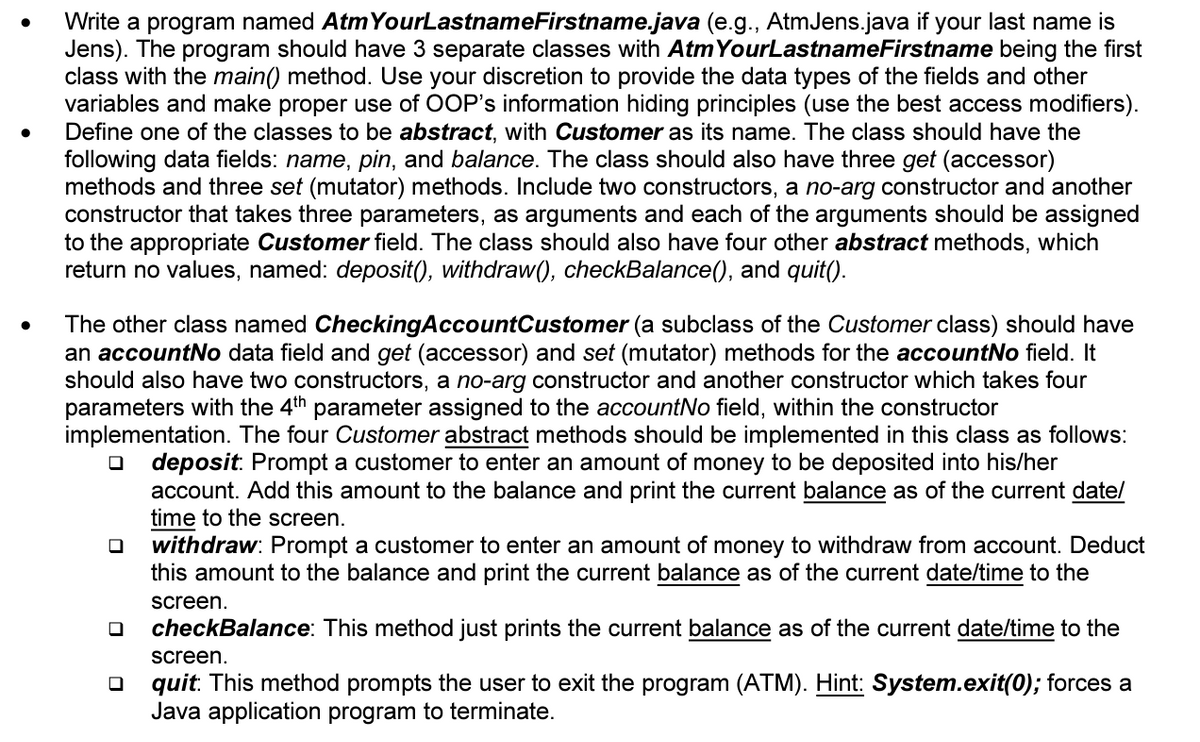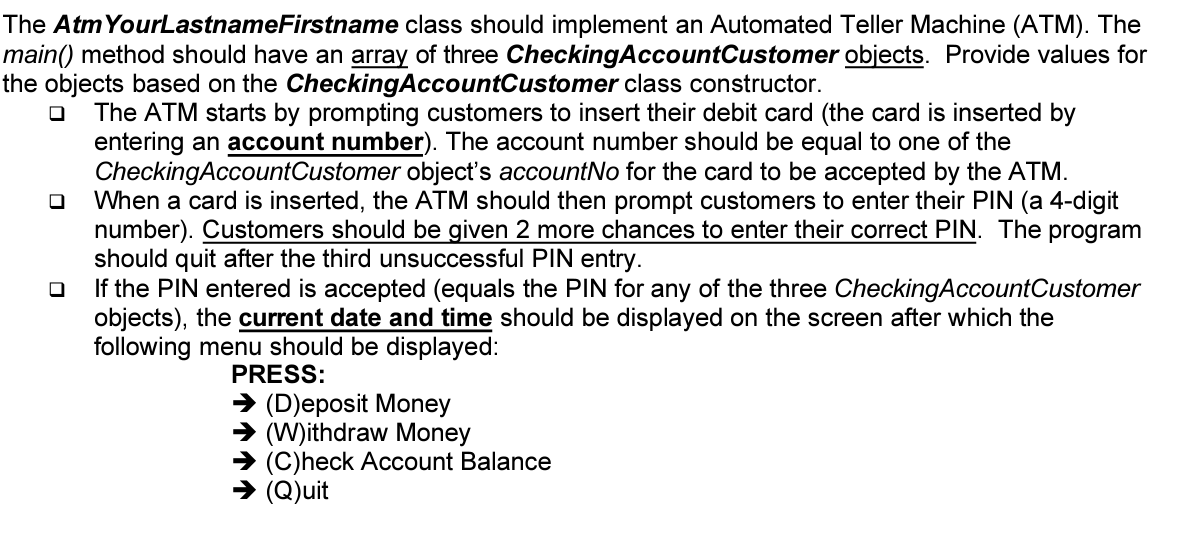Please look at the images for the programming question. I am not sure sure where I should start on this. All coding is done in Java, using IntelliJ Idea.
Please look at the images for the programming question. I am not sure sure where I should start on this. All coding is done in Java, using IntelliJ Idea.
Computer Networking: A Top-Down Approach (7th Edition)
7th Edition
ISBN:9780133594140
Author:James Kurose, Keith Ross
Publisher:James Kurose, Keith Ross
Chapter1: Computer Networks And The Internet
Section: Chapter Questions
Problem R1RQ: What is the difference between a host and an end system? List several different types of end...
Related questions
Question
100%
Please look at the images for the
I am not sure sure where I should start on this.
All coding is done in Java, using IntelliJ Idea.

Transcribed Image Text:Write a program named AtmYourLastnameFirstname.java (e.g., AtmJens.java if your last name is
Jens). The program should have 3 separate classes with AtmYourLastnameFirstname being the first
class with the main() method. Use your discretion to provide the data types of the fields and other
variables and make proper use of OOP's information hiding principles (use the best access modifiers).
Define one of the classes to be abstract, with Customer as its name. The class should have the
following data fields: name, pin, and balance. The class should also have three get (accessor)
methods and three set (mutator) methods. Include two constructors, a no-arg constructor and another
constructor that takes three parameters, as arguments and each of the arguments should be assigned
to the appropriate Customer field. The class should also have four other abstract methods, which
return no values, named: deposit(), withdraw(), checkBalance(), and quit().
The other class named CheckingAccountCustomer (a subclass of the Customer class) should have
an accountNo data field and get (accessor) and set (mutator) methods for the accountNo field. It
should also have two constructors, a no-arg constructor and another constructor which takes four
parameters with the 4th parameter assigned to the accountNo field, within the constructor
implemer
on. The four Customer abstract methods should be implemented in this class as follows:
deposit: Prompt a customer to enter an amount of money to be deposited into his/her
account. Add this amount to the balance and print the current balance as of the current date/
time to the screen.
withdraw: Prompt a customer to enter an amount of money to withdraw from account. Deduct
this amount to the balance and print the current balance as of the current date/time to the
screen.
checkBalance: This method just prints the current balance as of the current date/time to the
screen.
quit: This method prompts the user to exit the program (ATM). Hint: System.exit(0); forces a
Java application program to terminate.

Transcribed Image Text:The AtmYourLastnameFirstname class should implement an Automated Teller Machine (ATM). The
main() method should have an array of three CheckingAccountCustomer objects. Provide values for
the objects based on the CheckingAccountCustomer class constructor.
The ATM starts by prompting customers to insert their debit card (the card is inserted by
entering an account number). The account number should be equal to one of the
CheckingAccountCustomer object's accountNo for the card to be accepted by the ATM.
When a card is inserted, the ATM should then prompt customers to enter their PIN (a 4-digit
number). Customers should be given 2 more chances to enter their correct PIN. The program
should quit after the third unsuccessful PIN entry.
If the PIN entered is accepted (equals the PIN for any of the three CheckingAccountCustomer
objects), the current date and time should be displayed on the screen after which the
following menu should be displayed:
PRESS:
→ (D)eposit Money
(W)ithdraw Money
→ (C)heck Account Balance
> (Q)uit
Expert Solution
This question has been solved!
Explore an expertly crafted, step-by-step solution for a thorough understanding of key concepts.
This is a popular solution!
Trending now
This is a popular solution!
Step by step
Solved in 4 steps with 2 images

Recommended textbooks for you

Computer Networking: A Top-Down Approach (7th Edi…
Computer Engineering
ISBN:
9780133594140
Author:
James Kurose, Keith Ross
Publisher:
PEARSON

Computer Organization and Design MIPS Edition, Fi…
Computer Engineering
ISBN:
9780124077263
Author:
David A. Patterson, John L. Hennessy
Publisher:
Elsevier Science

Network+ Guide to Networks (MindTap Course List)
Computer Engineering
ISBN:
9781337569330
Author:
Jill West, Tamara Dean, Jean Andrews
Publisher:
Cengage Learning

Computer Networking: A Top-Down Approach (7th Edi…
Computer Engineering
ISBN:
9780133594140
Author:
James Kurose, Keith Ross
Publisher:
PEARSON

Computer Organization and Design MIPS Edition, Fi…
Computer Engineering
ISBN:
9780124077263
Author:
David A. Patterson, John L. Hennessy
Publisher:
Elsevier Science

Network+ Guide to Networks (MindTap Course List)
Computer Engineering
ISBN:
9781337569330
Author:
Jill West, Tamara Dean, Jean Andrews
Publisher:
Cengage Learning

Concepts of Database Management
Computer Engineering
ISBN:
9781337093422
Author:
Joy L. Starks, Philip J. Pratt, Mary Z. Last
Publisher:
Cengage Learning

Prelude to Programming
Computer Engineering
ISBN:
9780133750423
Author:
VENIT, Stewart
Publisher:
Pearson Education

Sc Business Data Communications and Networking, T…
Computer Engineering
ISBN:
9781119368830
Author:
FITZGERALD
Publisher:
WILEY